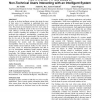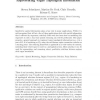287 search results - page 14 / 58 » Mental Models in Spatial Reasoning |
CANDC
2009
ACM
13 years 6 months ago
2009
ACM
Supporting users' reasoned imagination in sense making during interaction with tangible and embedded computation involves supporting the application of their existing mental ...
CONSTRAINTS
2006
13 years 8 months ago
2006
Topological relations are important in various tasks of spatial reasoning, scene description and object recognition. The RCC8 spatial constraint language developed by Randell, Cui...
CHI
2007
ACM
14 years 9 months ago
2007
ACM
In order to develop intelligent systems that attain the trust of their users, it is important to understand how users perceive such systems and develop those perceptions over time...
IJAR
2008
13 years 8 months ago
2008
Qualitative spatial information plays a key role in many applications. While it is well-recognized that all but a few of these applications deal with spatial information that is a...
IJCAI
2001
13 years 10 months ago
2001
This paper describes the Region Occlusion Calculus (ROC-20), that can be used to model spatial occlusion and the effects of motion parallax of arbitrary shaped objects. ROC-20 ass...


